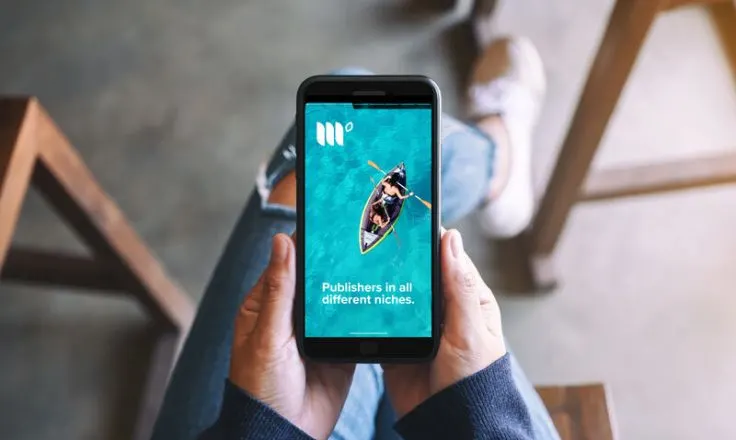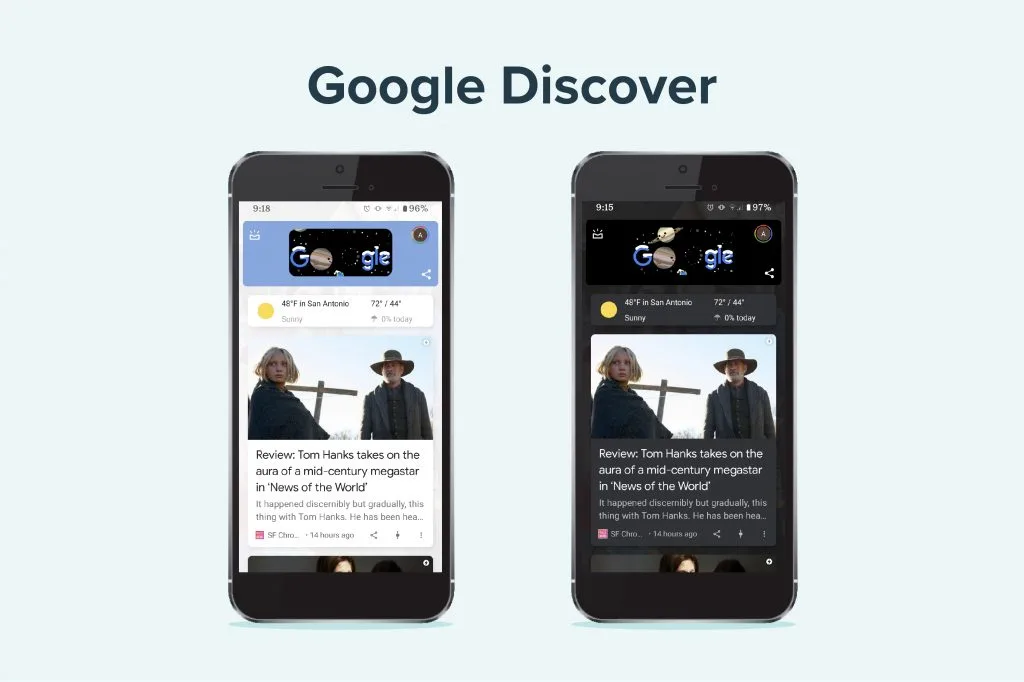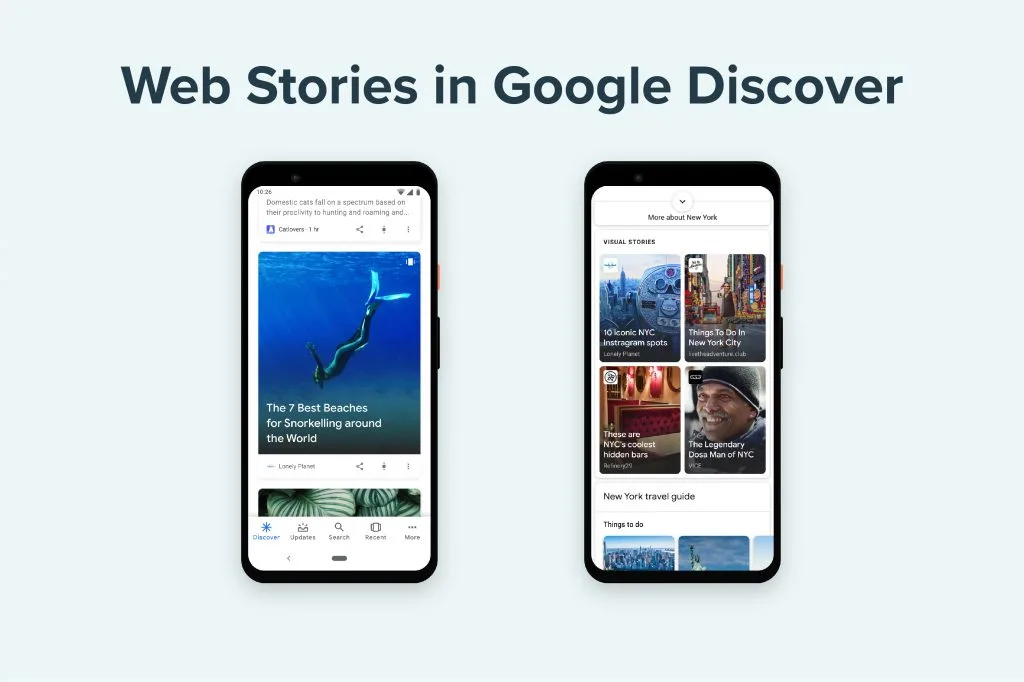Google Web Stories SEO: What You Need to Know


2022 Update: For the most up to date information from Mediavine about Google Web Stories, please read our Web Stories FAQ.
As you may have heard in the news or from other publishers, Google’s AMP story format has recently been rebranded.
Welcome, Google Web Stories!
Stories are all the rage online these days, and with this new name change, they’ve at last become a “first class citizen” over at Google.
Web Stories will have their own dedicated carousel in Google Discover, which means a whole new opportunity for publishers to position their content for coveted, organic search traffic.
So how do you build Web Stories for Google and optimize them for SEO? Glad you asked, because we’ve got answers for you with the return of Mediavine’s SEO Like A CEO series below!
Google Web Stories are mini-AMP pages, or embeds that you create for posts on your site. They end up looking like the visual slideshows you’ve likely seen grow in popularity on Facebook and Instagram stories.
Think of Stories as a series of quick images or videos that a user can flip through and, well, tell the story you want to tell.
When it’s over, there’s a nice little Call to Action (CTA) that can encourage audiences to visit your site for additional information.
If your website is powered by WordPress, you’re in luck.
Google has released an official Web Story plugin for WordPress, and that’s literally all you need to make Web Stories. It’s a great little drag-and-drop interface that includes templates to help get you started.
We’ll save the full web stories tutorial for a Amber’s blog post, and Google has some great documentation on the plugin to walk you through that part too.
Once you create the story, the plugin makes a new Web Story custom post for you to publish – though it won’t appear on your homepage feed.
So where does this post live, and how do you start getting traffic to it? That’s where this guide fits in.
Web Stories live on their own mini-pages within WordPress, and you don’t actually have to embed them or send them traffic yourself.
In fact, you don’t want to.
We’ll talk a little more about ads for Web Stories in a bit, but in short, they will not monetize as well as a regular blog post.
You want to use Web Stories to augment your blog post, and make readers want to read it as well as enjoy your web story. You do not want to divert traffic from the blog post to its Web Story.
For that reason, we do not recommend embedding Web Stories.
The goal is to bring in thousands of new visitors to Web Stories from Google Discover. Then, the CTA at the end of those stories will entice readers to visit your site, where your ads are optimized.
Sound good? We had a feeling it would. Follow this short guide to Web Story SEO to make it happen.

This may seem counterintuitive, as you obviously want to rank on your latest content. However, this follows my usual mantra:
If Google thinks you’re an expert on a particular topic, they’re going to think you’re an expert in a Web Story about it.
Creating Web Stories for a top post is the same strategy as making a Recipe Card or a video for it. Think of it as an ad for your content.
The reason you’re doing this is twofold. One, you’re likely to rank well on that Web Story and two, this is a NEW spot for Google to show off your expertise.
It’s additional traffic in Google Discover you wouldn’t have received with your organic ranking alone. Even if you’re already ranked #1 for a particular article, it’s still a net gain of new traffic!
According to Casey Markee of Media Wyse, publishers are already seeing serious results from Web Stories.
Markee, who recommends bloggers create stories for their top 3-10 posts, says “the results have been fantastic … I had one blogger who generated 20,000 clicks from Google in ONE DAY from stories.”
To give you an idea of the potential here, another blogger he spoke of has generated 50,000+ sessions in December with Web Stories thus far!
While Google recommends that publishers embed the Web Story in your posts, I don’t actually like this tactic, and I’ll explain why.
First, featuring the embed is going to slow down your page.
Additionally, if you create Stories the way we’re encouraging – and the way in which they make the most logical sense for both user experience and ad monetization – they’re previews of your content. Putting that preview within the content itself doesn’t serve any purpose.
Finally, and most importantly, you simply don’t have to. If you’re running the plugin, each story gets its own permalink on your site, and its own chance to rank. You do not need to embed them to rank, so don’t.
Google also recommends “deeply integrating Stories” in ways such as linking to them from your homepage or relevant category pages.
That’s definitely a great idea if you have static homepages or category pages, where it’s easy to add unique content, like on Trellis.
If you don’t have an easy way to link from relevant categories, or end up with too many Stories for this to be practical, I have an easier solution.
As with regular organic search, Google is trying to learn about the Story based on what external and internal links go to it.
Can you guess what content will be the most similar to the Story you’re writing? That’s right, the post you’re telling a story about.
Linking to Stories from posts you’re writing them about will definitely help Google find them, without the disadvantages of embedding.
Google also wants publishers to create a separate Web Story landing page, which will feature links to all of your Web Stories, and then link to that landing page from your homepage.
I recommend going with the default landing page WordPress makes for custom post types (e.g. yourblog.com/web-stories).
Chances are, the page won’t look pretty, but it will get the links you need. So try linking to this page in your sidebar – less prevalent than your top navigation, but still noticeable enough to get the job done.
Think back to my site structure post. Your goal is to keep the landing page one click from your homepage, so Web Stories are two clicks from the homepage. (Google and SEO Like a CEO, intersecting as always.)
Assuming you’re running a plugin like Yoast to generate XML Sitemaps, you should have one for Web Stories. It will likely be at yourblog.com/web-story-sitemap.xml.
If not, make sure to configure your SEO plugin to generate these and submit it via the Google Search Console.
This one is a little trickier, because you obviously know it’s important to optimize the page title for SEO, but it’s also important to remember to avoid creating duplicate page titles on your website.
Your goal is just not to trigger the Google Search duplicate title filter. Pick a name that makes sense for the keyword you’re targeting, but isn’t the name of your post. Make sure it’s enticing for the viewer, because they will see your title in Discover, over the cover image of your story.
Google says the secret to a Web Story ranking is still all about content. In Google’s best practices advice, they recommend 10-20 slides, keeping the content per slide brief, and keeping it visual, with plenty of images and videos that fill up the screen.
They’ve since expanded on that with this article on what a web story should be.
As usual, with any “content is king” strategy, it also means you need to make a lot of content. Create stories for all of your top posts, then consider a Web Story for any new post you create as well.
Yes, it’s work, but once you see the traffic, you’ll find it’s worth it.
When it comes to SEO, Web Stories are just like any other page to Google. Everything from using alt text to properly using your keywords in your content will make a difference. As Google says, “If it helps rank your non-Story pages, it’ll probably help the Stories as well.”

According to Markee, who as we mentioned above has already worked extensively with bloggers on Web Stories in this early stage, there are some common technical caveats to be aware of as well:
/web-stories/(.*)The Web Story plugin provides a place to input your Google Analytics ID, and it can automatically insert the proper tracking code for you.
You do not need the Google Site Kit plugin, despite the language in the settings page, in order to do this.
My recommendation is to consider setting up a separate Google Analytics Profile to track Web Stories. Why? Because traffic to Web Stories is not really the same as traffic to your site.
As we’ve touched on multiple times above, think of stories as ads that run inside Google Discover for your content. The goal of Web Stories should be getting users to click over to your site, that’s it.
It’s not really your traffic until they leave the Web Story experience and arrive on your website, so don’t count it as such.
If you combine stories with your primary Analytics, you’ll see a surge of users who are virtually un-monetized; all that will do is hurt your RPM calculation, while also making everything harder to track.
Markee and Google recommend you set up a separate Dashboard inside your Google Analytics in order to track the performance of your stories.
Setting up a new dashboard to easily track your Web Stories’ performance, so you’ll know how to optimize them to convert more users into real traffic, but in left inside your regular unfiltered profile or view, will still impact RPM calculations. Here is our help guide on setting up a new Google Analytics Profile ID for your Web Stories.
Additionally, to prevent the Web Stories tracking URL parameter from breaking your dashboard page-level reporting, you should set your analytics profile to ignore the following parameter: _gl .
You can follow our help doc on how to exclude a URL parameter easily in Google Analytics. Reach out to publishers@mediavine.com if you have any questions on how to do this.
We’ve talked a lot about looking at these as previews or ads, in a sense, for your content. Unfortunately, since Web Stories are their own “pages” on your site, they may show up when a user searches your site.
This applies both on your internal site search itself and on Google results pages.
For internal searches, you can control this; Users can find the “exclude option” for Web Stories if they go into their Web Stories plugin, go to their list of Web Stories, and click on “Quick Edit.”
Nevertheless, there’s always some chance that Web Stories will appear in Google Search Results, and that’s just a fact of life; removing them from Google Search would negate their ability to get you traffic.
Just do your best to make sure your main post ranks better through SEO than your stories, and don’t overthink this.
As of this post, integrating Mediavine ads in Web Stories is still in its very early alpha/beta testing.
If you’re receiving significant traffic from Web Stories and want to help us test Mediavine ads within them, email publishers@mediavine.com. We hope to release these ad solutions more widely in early 2021.
However, even when we’re able to monetize stories at a wider scale, there are some important caveats:
All of the above bullet points can be summarized as such:
Your ability to monetize traffic will be many times stronger on your post. If and when you can run ads on these stories, we’re still only talking about a single, low-filling ad per story.
Not to sound like a broken record here, but you shouldn’t expect to make significant revenue from the Stories themselves right now. Instead, think of Web Stories as a cool way to access an entirely new audience for your site and its great content.
We’ll keep working to improve how Stories monetize, and continue to bring you updates on this exciting platform as they develop.
Stay up to date with the latest from Mediavine
Publishers spend time creating great content that keeps readers coming back, and we know that safeguarding that content and maintaining control over how it’s used are critical concerns in today’s …
 Eric Hochberger
Eric Hochberger
In a blog post last week, Google announced plans to launch generative AI into Search Labs with a new product called Search Generative Experience (SGE). What exactly is SGE, and …
Since ChatGPT’s release in November 2022, OpenAI’s prototype of generative AI — that is, artificial intelligence that can produce new content on demand — has dominated popular tech media. We’ve …